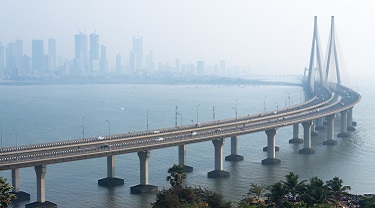India is a market with tremendous potential for Canadian exporters. Already the world’s largest democracy, India surpassed China as the most populous country overall in 2023.
India’s economy is expanding at a similar rate. With a gross domestic product (GDP) of US$3.8 trillion, it’s now the world’s fifth-largest economy, with a healthy growth rate expected to continue for the next decade.
Favourable demographics are driving this trend. Almost two-thirds of India’s 1.5 billion people are under 35, providing the nation with a robust workforce, and its growing middle class has more money to spend on goods and services.
The Indian government’s stated goal is to make it a “developed nation” by 2047, when India celebrates 100 years of independence. To that end, India’s encouraging foreign investment and trade to build infrastructure and increase the economy’s capacity to meet the demands of its vast and diverse population. These developments are enormously significant for the global economy and Canada’s trade and investment prospects in the Indo-Pacific region.
“As an economy, India is developing infrastructure (roads, rail and air), advanced manufacturing and digital industries at a massive scale. The public and private investments required in these sectors provide Canadian companies the opportunity to ride this expansion plan and make a foothold in the Indo-Pacific,” says Neil Krell, Export Development Canada’s (EDC) chief representative for South Asia.
India and Canada’s trade relationship
Canada and India share a strong commercial relationship. Despite the recent political and diplomatic tensions, commercial engagement hasn’t been significantly impacted, underscoring the strong alignment of bilateral interests.
With goods exports valued at $5.1 billion in 2023, India was Canada’s ninth-largest export market. For comparison, goods exports in 2018 were $4.4 billion. Canada-India bilateral trade in goods was valued at $12.7 billion in 2023. In the same year, bilateral trade in services rose to $17.3 billion. Roughly 400 Canadian companies of all sizes operate in India.
EDC’s trade team in India
India is a priority market for both Export Development Canada (EDC) and the Canadian government. Canada’s Indo-Pacific Strategy recognizes the region as a critical hub for trade, investment, and production.
To help Canadian companies take advantage of opportunities in the region, EDC is increasing our investment in the Indo-Pacific, including India. We’ve had representations in Delhi since 2005 and Mumbai since 2007, where our teams focus on creating new pathways for Canadian companies to do business in India. We’re committed to building strategic relationships with local market leaders, forging effective partnerships, and strengthening ties between our countries through trade.
What does Canada export to India?
Canada exports a wide range of goods to India, but a few items/commodities make up the bulk of our exports. For example, Canada is India’s primary source for lentils, which are a staple of the Indian diet. In 2023, around 53% of lentils imported by India were from Canada. The top Canadian goods exported to India in 2023 included:
- Bituminous coal ($1.1 billion)
- Lentils ($738.4 million)
- Potassium chloride ($571.7 million)
- Newsprint ($295 million)
- Diamonds ($200.6 million)
Top opportunities for Canada-India trade
With its vast economy, India offers opportunities across a wide range of industries. Sectors where Canada has a comparative advantage for exports include:
- Infrastructure
- Artificial intelligence (AI) and digital services, including gaming and the Internet of things (IOT)
- Cleantech, focusing on water treatment and emissions control, including carbon capture, utilization and storage (CCUS)
- Renewable energy (wind, solar and hydroelectric)
- Agri-food and agricultural technologies, especially farm mechanization, supply chain management and food processing. Indian farmers are keenly interested in technologies for water treatment and soil nutrient enhancement.
- Electric vehicle (EV) ecosystems, including electric charging, battery storage technologies and EV drive motors for everything from two-wheeled vehicles to large SUVs and commercial vehicles.
- Health care, including high-end diagnostic services, medical devices and medical consumables
- Advanced manufacturing, especially in the pharmaceutical, precision machining and robotics sectors
Regional markets in India
As with many large, populous nations, there’s no single “Indian market.” India’s regions are diverse, and each regional market has millions of consumers. This fact is good news for medium-sized Canadian businesses. With good market research and an effective export strategy, it’s possible to find plenty of customers for your products and services in one corner of the country, which can simplify market entry.
| Region | Key industries |
| Mumbai and the state of Maharashtra | • Financial services • National/global business headquarters |
| Karnataka | • Advanced manufacturing |
| Gujarat | • Oil & gas, chemicals |
| Hyderabad and Bengaluru | • Technology, IoT, business process outsourcing, knowledge process outsourcing, Global Competence Centres and AI |
| Punjab, Haryana, Madhya Pradesh | • Agriculture and agri-foods |
| Jharkhand, Bihar, West Bengal, Orissa (Eastern India) | • Mining • Natural resources |
| Pune and Chennai | • Automobiles and auto ancillary |
| Tamil Nadu | • Tea, coffee and other cash crops • Rare earths |
Manufacturing incentives from Invest India
Introduced by the Government of India in 2020, the production linked incentive (PLI) gives companies incentives on incremental sales (over the fiscal year 2019-2020) from products manufactured in Indian locations. The incentive structure is available for 14 sectors, including: Pharmaceuticals, automobiles and auto components, telecom, networking products, advanced chemistry cell batteries, textiles, food products, solar modules, white goods and specialty steel.
You should also check out
Read this Export Development Canada guide on doing business in India
How India’s digital transition is transforming the market
India’s quickly built a digital economy that offers seamless digital processes for businesses and consumers alike. It’s now one of the world’s largest markets for digital technologies, cybersecurity and related industries.
“The post-COVID-19 world has been a shot in the arm for digitalization across the board,” says Ruzan Desai, EDC’s regional manager for India.“ Today, India has one of the highest numbers of digital transactions in the world, with more than a billion users.
“Digital wallets and the homegrown Unified Payments Interface (UPI) have democratized digital services by enabling digital payments for purchasing anything from a coconut to a car,” Desai says.
The benefits of digitalization aren’t restricted to India’s major cities. “A noteworthy change in recent years has been the growth of rural India and increasing purchasing power of people living in Tier 2 and Tier 3 cities,” he says. “Access to affordable credit, digitalization, increasing standards of living and an aspirational middle class are all contributing to the development of India beyond the Top 5 metros.”
The shift to digital payments means Canadian companies can now sell a wide range of goods directly to Indian consumers through e-commerce platforms, eliminating the expense and complications of maintaining a physical presence in local markets. The e-commerce boom has also created new opportunities for companies with solutions for last-mile connectivity, inventory management and delivery technologies to support the e-retail space.
Indian companies, especially in industries like health care and education, are increasingly adopting digital technologies, including video conferencing and virtual teams. This shift is an opportunity for Canadian businesses that develop efficient and cost-effective ways to deliver digital solutions to remote areas. Canada’s expertise in this subsector dovetails neatly with the needs of the Indian market.
India’s improving business environment
In the 2014 Ease of Doing Business Index, India ranked 130th out of 190 countries. By 2019, the country had risen to 63rd.
This improvement reflects the Indian government’s decades-long commitment to deregulating industry, reducing tariffs, cutting domestic taxes, and simplifying international investment rules. Challenges due to bureaucracy, tariffs, and environmental, social and governance (ESG) concerns persist, but India is making clear progress in transforming its business environment and creating conditions favourable for economic growth.
Business challenges in India
Like any market, India presents a range of challenges for both exporters and investors, including:
- Competition
Indian companies and consumers are extremely price sensitive, and you’ll be up against entrenched competition from local and international businesses. Consequently, your profit margins may be thin, even if you reduce costs by setting up operations in India.
- Unpredictable and opaque regulatory regimes
India has higher tariffs than some of Canada’s traditional export markets, and regulatory regimes can change with little notice due to government policy shifts. Rules and procedures sometimes lack transparency, making it harder to navigate Indian customs clearances, permits and visas. Recent efforts to reduce complexity for businesses, such as India’s adoption of a goods and services tax (GST), are improving the regulatory environment, but significant challenges remain to be solved.
- Absence of a Canadian industrial ecosystem
There’s no Canadian industrial ecosystem within the Indian economy that can pull related Canadian businesses into the country. Developed Asian economies, in contrast, have established networks of interconnected players operating in India, especially in its automotive and industrial engineering sectors. Supporting the development of a Canadian trade ecosystem in India is a priority for EDC.
- Undeveloped infrastructure
India is urbanizing rapidly and straining to build and upgrade the roads, railroads, ports, airports and power grids required to sustain a modern economy.
- A different business culture
Indians use personal relationships to build mutual trust. This habit extends to business to a degree that’s less common in Canada. The relationship-driven nature of Indian business culture is why local partners can be critical, especially at the market-entry stage. Learn more about Indian business etiquette.
- Environmental, social and governance (ESG)
As with any market, there are ESG challenges and opportunities associated with business activities in India. EDC encourages all Canadian companies to follow the Government of Canada’s approach to responsible business conduct abroad. Learn more about EDC’s approach for ESG.
Leveraging local partners
Given the complex and personal nature of the business environment, working with Indian partners can help Canadian companies overcome some of the market’s key challenges. A local partner can:
- Identify and hire local talent for business development and interactions with local business and government entities.
- Help you navigate the culture and develop strategies tailored to the market.
- Work directly with Indian companies as your in-market representative.
You may also consider partnering with strong, creditworthy corporate groups to gain from their expertise as you enter the Indian market.
Having an Indian partner is less critical in industries such as AI, IOT and advanced manufacturing, where products are delivered remotely, and competition is based solely on technology and price.
Top tips for doing business in India: The three Ps
- Patience: It can take three to five years from market exploration to your first contract.
- Presence: India’s markets are relationship driven, so face-to-face meetings and a local presence are vitally important.
- Price: India is a price-competitive market. With its proximity to China and Japan, India has access to cheaper products, which consumers and businesses often prefer. But Canada is a source of value because it offers quality goods and services.
You should also check out
Get the latest market intelligence to manage trade volatility and tariffs and find opportunities for growth.
Support for importing into India
Trade Commissioner Service (TCS)
Canada’s TCS has eight trade offices across India. With specialized knowledge of key sectors, TCS excels at forging connections with associates who can help Canadian companies do business in India.
Export Development Canada
EDC is part of the Government of Canada’s trade ecosystem of experts available to help you save time, learn more about your target markets and access the capital you need to grow. As part of our Indo-Pacific strategy, EDC is committed to helping Canadian companies diversify into new markets and succeed in this dynamic region.
From our representations in Mumbai and Delhi, EDC’s experienced team builds relationships with Indian businesses and institutions to find opportunities that Canadian companies might otherwise overlook. We’re a member of the Indo-Canadian Business Chamber (ICBC) and the Canada-India Business Council (CIBC). These associations provide valuable introductions, networking opportunities, business events and more.
EDC also offers:
- A full suite of credit insurance products to lower your risk for doing business abroad
- Help with getting access to working capital
- Expertise to enable you to learn more about international markets
- Connections to international companies in need of your products and services
Learn more about how EDC’s financial and knowledge solutions can help you understand the opportunities in your target market and make exporting less risky. To contact an EDC export advisor, visit our Export Help Hub.
Interested in growing your business in India and the Indo-Pacific?
Connect with EDC and watch your business flourish on the international stage.
Answer a few questions about your company to learn more about how EDC can help you plan, connect and fuel your expansion in the Indo-Pacific.







